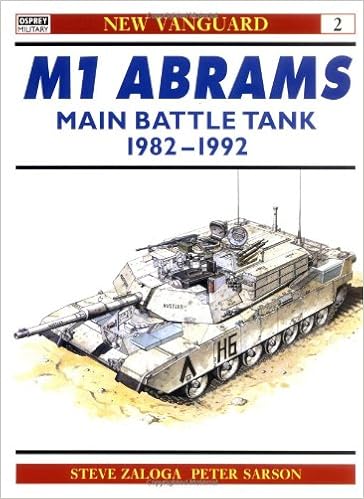
Review (PDF) M1 Abrams Main Battle Tank 1982-92 (New Vanguard)

The M1 Abrams was the most radical departure in US tank design since World War II. Until the advent of the M1 in the early 1980s, the US Army had relied on the steady evolution of the M26 Pershing tank, through the M46, M47, M48 and M60. The M1 design came at a time when there were a host of important new tank technologies coming to fruition, in terms of structure and weaponry: these were integrated into it. This book details the design, development and operational use of one of the world's best main battle tanks.

Series: New Vanguard (Book 2)
Paperback: 48 pages
Publisher: Osprey Publishing (January 28, 1993)
Language: English
ISBN-10: 1855322838
ISBN-13: 978-1855322837
Product Dimensions: 7.3 x 0.1 x 9.9 inches
Shipping Weight: 3.2 ounces (View shipping rates and policies)
Average Customer Review: 4.0 out of 5 stars See all reviews (9 customer reviews)
Best Sellers Rank: #492,702 in Books (See Top 100 in Books) #66 in Books > History > Military > Weapons & Warfare > Conventional > Armored Vehicles #17374 in Books > Engineering & Transportation > Engineering

This book, having been written in the early 1990s, concentrates on the M1A1 Abrams tank that was used in the Gulf War of 1991. However, Zaloga does not skimp on the Abrams' developmental history, starting off with the M26 Pershing-derived Patton and M60 series and the failed MBT-70 and XM803 tanks of the late Vietnam era. He also describes the competition between the Chrysler and General Motors prototypes and the German Leopard II entry, and how a modified Chrysler model with the novel turbine engine won out. Also described in some detail is the composition of the Burlington/Chobham armor, including millimeter-equivalent of protection on the front of both the original M1 and the later M1A1 tanks. The main guns and their ammunition are covered in detail, including muzzle velocity and penetration figures for various rounds. Rounding out the development with a discussion of fire control system and staged upgrades, Zaloga moves on to the operational history during the Gulf War.Considering the age of the original text, it is impressive that Zaloga covers upgrades that have only recently been implemented such as the M1A1-D and M1A2 digitized tanks. Naturally, more recent developments such as AIM and M1A2SEP are missing, as these are just now entering service. In the last pages, he includes several line drawings showing profiles of the four major variants of the Abrams tank, facilitating easy comparison. He also mentions the armored recovery vehicle which was not procured, and the bridgelayer which is just now entering service as the M104 Wolverine after nearly being cancelled outright.
Overall a good book but could have used tighter editing. I would give it a 4.5 if I could.It was published in January of 1993 so he was busy researching and writing in the years that followed the First Gulf War. The backdrop was a victorious US Army and the M1 played a vital role in that victory. It was a tank that everyone wanted to know more about.He covers most major topics about the tank but none in much detail which is understandable given the limited page count of the Osprey books. He discusses the story of the development of the M1 but for a more detailed treatment I would recommend you read Orr Kelly's book, "King of the Killing Zone". I have not yet read Hunnicutt's book about the M1 so I cannot say how Kelly and Hunnicutt compare.There are, however, some minor problems with this book.Pictures are flipped reversing right and left. The dog house, another name for the structure housing the gunner's primary sight, is always on the right side of the tank in front of the tank commander's 50 cal MG. The external APU was mounted on the right rear. Pictures appear to be flipped on pages - 1, 17, 19, 20, 38 top left.On page 8 Dr. Philip Lett Jun is metioned. With a last name of Jun is he Korean? Nope, apparently Osprey always translates US English into the Queen's English where Jun. is an abbreviation for Junior which would be more recognizable if they had left it as the American English abbreviation Jr. Armour and Programme are spellings that I am familiar with but why do this in the first place? Zaloga was born in the USA and went to school and received his degrees in the USA. The Queen's English does not come naturally to him. Why translate his manuscript into the Queen's English?
M1 Abrams Main Battle Tank 1982-92 (New Vanguard) Isolation Tank: Understanding the Sensory Deprivation Tank and What You Need to Know (Flotation Tank, Meditation, Float Tank, Relaxation, Think Tank, Reduce Stress) T-72 Main Battle Tank 1974-93 (New Vanguard) Leopard 1 Main Battle Tank 1965-95 (New Vanguard) New Vanguard 80: Chieftain Main Battle Tank 1965-2003 Modelling the T-55 Main Battle Tank (Osprey Modelling) T-34-85 Medium Tank 1944-94 (New Vanguard) Churchill Infantry Tank 1941-51 (New Vanguard) Tank Warfare (Battle Tactics) Kursk: The Greatest Tank Battle Hanford's Battle with Nuclear Waste Tank Sy-101: Bubbles, Toils, and Troubles The Abrams Guide to Period Styles for Interiors Ramsey and Abrams' Children and the Law in a Nutshell, 4th The Vikings: Lord of the Seas (Abrams Discoveries) Discoveries: Story of Jazz (Discoveries (Harry Abrams)) Study Guide for Abrams' Clinical Drug Therapy Mil Mi-24 Hind Gunship (New Vanguard) Commonwealth Cruisers 1939-45 (New Vanguard) Fighting Ships of the Far East (2): Japan and Korea AD 612?1639: Japan and Korea AD 612-1639 v. 2 (New Vanguard) Sturmgeschutz III and IV 1942-45 (New Vanguard, 37)



